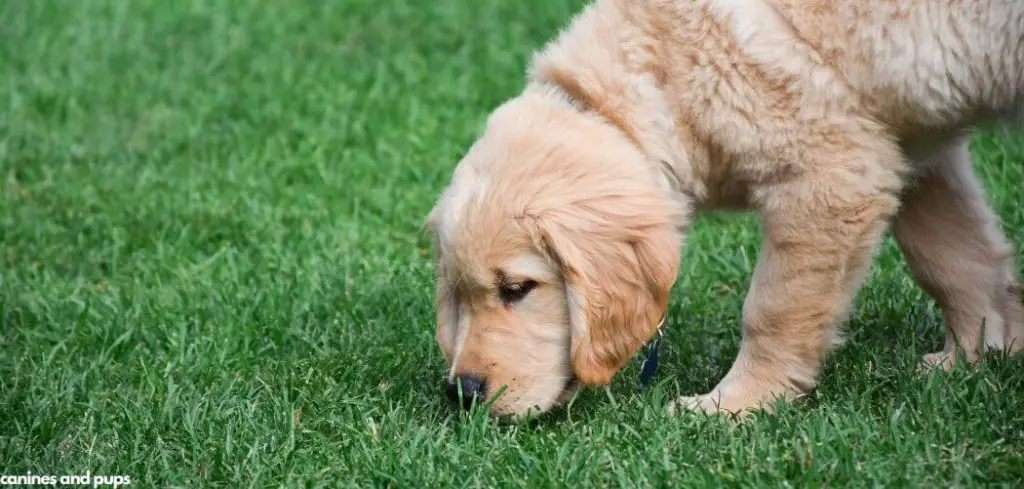It can be alarming when your old dog starts eating dirt, as this behavior can signal underlying health or nutritional issues.
While some dogs may occasionally nibble soil out of curiosity, frequent or compulsive dirt eating in senior dogs should not be ignored.
We outline the common reasons for an old dog eating dirt, what you can do at home, and when to seek veterinary help.
Old Dog Eating Dirt — Why It Happens
An old dog eating dirt can stem from a range of causes, including medical conditions, dietary deficiencies, or behavioral issues. Senior dogs may develop pica, a condition characterized by the consumption of non-food items, due to anemia, gastrointestinal problems, or nutrient imbalances.
Other times, dirt eating can result from boredom, stress, or habit, particularly if the dog has limited stimulation.
Monitoring associated symptoms, such as vomiting, diarrhea, or lethargy, helps determine whether a veterinary evaluation is needed.

Old Dog Eating Dirt: Common Causes
Nutritional Deficiencies
Older dogs may eat dirt if their diet lacks essential minerals or vitamins. Deficiencies in iron, calcium, or other nutrients can trigger pica behaviors as the dog seeks missing nutrients in soil.
Owners might notice increased dirt eating alongside poor coat condition, lethargy, or weight loss.
Left unaddressed, nutritional deficiencies can weaken immunity and overall health, making dietary adjustments crucial.
Read more: Old Dog Eating But Losing Weight (Here’s Why)
Gastrointestinal Disorders
Digestive issues, such as inflammatory bowel disease, malabsorption, or chronic gastrointestinal irritation, can lead to dirt eating.
Dogs may instinctively seek out non-food items to soothe upset stomachs or compensate for poor nutrient absorption.
Signs include vomiting, diarrhea, changes in stool consistency, and decreased appetite. Gastrointestinal disorders in senior dogs can quickly become serious due to dehydration or nutrient loss, requiring prompt attention.
Anemia or Blood Disorders
Anemia, often caused by chronic illness or internal bleeding, can trigger unusual cravings, including soil. Dogs attempt to supplement iron or other nutrients lost due to blood deficiencies.
Look for pale gums, fatigue, and reduced activity levels alongside dirt-eating behaviors. Untreated anemia can be life-threatening and should be evaluated immediately by a veterinarian.
Behavioral Causes
Stress, boredom, or anxiety can drive older dogs to eat dirt, especially if they spend long periods alone or without mental stimulation.
Habitual dirt eating may start as occasional exploration and progress to repetitive behavior.
Behavioral signs include pacing, restlessness, or chewing on other non-food items. While less dangerous than medical causes, behavioral pica can still lead to gastrointestinal blockages or exposure to harmful pathogens.
Parasites
Intestinal parasites, including hookworms or giardia, can cause nutrient depletion, prompting dogs to seek out soil for minerals.
Parasite infections often coincide with dirt eating as the dog attempts to satisfy cravings caused by nutrient loss.
Owners may notice diarrhea, weight loss, vomiting, or scooting behavior. Parasite infections can be serious in older dogs, as they can exacerbate existing health conditions and weaken the immune system.
Dental or Oral Issues
Painful teeth, gum disease, or oral discomfort may cause dogs to chew on dirt or other objects instead of properly eating their food.
Older dogs with dental problems may find chewing kibble difficult and may turn to softer or alternative textures found in the environment.
Signs include bad breath, drooling, reluctance to eat, and pawing at the mouth. Dental problems can affect nutrition and quality of life if not addressed, making prompt veterinary care important.
What to Do If Your Old Dog Is Eating Dirt
First, assess your dog’s diet and ensure it meets all nutritional requirements for senior dogs. High-quality, balanced food with adequate minerals, protein, and vitamins supports health and may reduce pica behaviors.
Provide fresh water and maintain proper hydration. Sometimes dogs eat soil due to mild dehydration or a need for minerals, so consistent access to water can help reduce the behavior.
Monitor behavior and offer enrichment. Regular walks, puzzle toys, and interaction can help alleviate boredom or anxiety that contributes to dirt eating.
Examine your dog’s environment. Remove access to contaminated soil, harmful chemicals, or objects that could be ingested, and supervise outdoor activities until the behavior is under control.
Schedule a veterinary visit. Your vet can rule out medical causes such as anemia, gastrointestinal issues, parasites, or dental disease, and provide appropriate treatments or dietary recommendations.
When to Call or Visit Your Vet
Seek immediate veterinary care if your old dog:
- Consumes large amounts of dirt or foreign objects rapidly.
- Displays vomiting, diarrhea, or blood in stool.
- Shows signs of lethargy, weakness, or weight loss.
- Exhibits sudden changes in appetite, drinking, or behavior alongside dirt eating.
Even occasional or mild dirt eating warrants attention if persistent or accompanied by other symptoms. Older dogs may hide discomfort, and early detection of underlying causes improves treatment outcomes.
Read more: Old Dog Not Eating (Here’s Why)
Key Takeaway
Eating dirt in older dogs can result from medical conditions, nutritional deficiencies, behavioral factors, or dental problems.
While some dogs may engage in occasional exploration without harm, frequent or compulsive soil eating can be dangerous and indicate underlying health issues.
Home strategies, such as proper nutrition, hydration, enrichment, and environmental management, can help reduce dirt-eating behaviors.
However, persistent or concerning behaviors always require veterinary evaluation to rule out serious conditions and ensure your senior dog’s health and safety.
